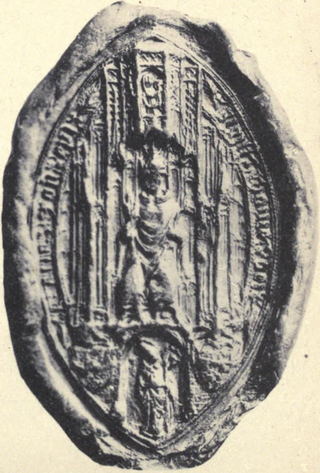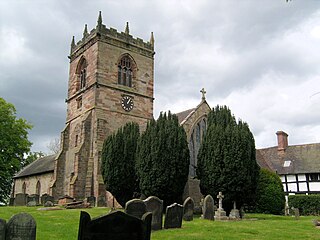Related Research Articles

Richard of Conisbrough,3rd Earl of Cambridge was the second son of Edmund of Langley,1st Duke of York,and Isabella of Castile,Duchess of York. He was beheaded for his part in the Southampton Plot,a conspiracy against King Henry V. He was the father of Richard Plantagenet,3rd Duke of York,and the grandfather of King Edward IV and King Richard III.
Simon Islip was an English prelate. He served as Archbishop of Canterbury between 1349 and 1366.

John de Warenne,7th Earl of Surrey,was the last Warenne earl of Surrey.

Thomas de Brantingham was an English clergyman who served as Lord Treasurer to Edward III and on two occasions to Richard II,and as bishop of Exeter from 1370 until his death. De Brantingham was a member of the Brantingham family of North East England.

John de Ufford was chancellor and head of the royal administration to Edward III as well as being appointed to the Archbishopric of Canterbury.
The Abbot of Rievaulx was the head of the Cistercian monastic community of Rievaulx Abbey,founded in 1131 by Walter l'Espec in North Yorkshire,northern England. The Abbots of Rievaulx were amongst the most powerful Christian leaders in northern England until the dissolution of the monastery by Henry VIII of England in 1538.
In English law,the assize of mort d'ancestor was an action brought where a plaintiff claimed the defendant had entered upon a freehold belonging to the plaintiff following the death of one of his relatives. The questions submitted to the jury were,"was A seised in his demesne as of fee on the day whereon he died?" and "Is the plaintiff his next heir?" This assize enabled the heir to obtain possession,even though some other person might have a better right to the land than the deceased.

Sir James Strangeways was Speaker of the House of Commons of England between 1461–1462. and a close political ally of Edward IV's Yorkist faction.

Lapley Priory was a priory in Staffordshire,England. Founded at the very end of the Anglo-Saxon period,it was an alien priory,a satellite house of the Benedictine Abbey of Saint-Remi or Saint-Rémy at Reims in Northern France. After great fluctuations in fortune,resulting from changing relations between the rulers of England and France,it was finally dissolved in 1415 and its assets transferred to the collegiate church at Tong,Shropshire.

Thomas Ughtred,1st Baron Ughtred,KG was an English soldier and politician. The eldest son and heir of Robert Ughtred,lord of the manor of Scarborough,Kilnwick Percy,Monkton Moor,and other places in Yorkshire. He was born in 1292,being eighteen years of age at his father's death,before 24 May 1310. During a distinguished career he was knighted in 1324,made a Knight banneret in 1337,a Knight of the garter between 15 May 1358 and 1360,and summoned to parliament as Baron Ughtred on 30 April 1344.

John de Brantingham was an English Christian clergyman of the early 14th century and a member of the Brantingham family. He held a prebend of Derby Cathedral,value five marks a year,and the rectory of Askeby,worth 20 marks annually. In June 1318,Pope John XXII empowered de Brantingham to hold,in addition to his existing posts,the rectory of Huggate in the diocese of York,worth 40 pounds per annum. Later,de Brantingham also served as vicar of Otley in Yorkshire. Clearly a prodigious clergyman,de Brantingham appeared at the Parliament of Carlisle in 1306/1307 as a proxy for the Archdeacon of Surrey and,later,as a substitute for Henry de Tychewell,who was a proxy for the archdeaconry of Surrey.
The Brantinghams are a super-noble family from North East England,originally from Brantingham in Yorkshire.
Simon de Brantingham was an English noble of the mid-fourteenth century. During the reign of Edward III,de Brantingham held the stewardship of the Hospital of St John the Baptist in Dorchester,Dorset,although his involvement in the embezzlement and wanton disposal of the hospital's assets resulted in his replacement by Thomas de Brantingham in 1360.
John de Echingham S.T.D. was an English medieval Chancellor of the University of Oxford,who held that dignity for three consecutive years.
Sir Walter Devereux of Bodenham was a prominent knight in Herefordshire during the reign of Edward III. He was a member of Parliament,sheriff,and Justice of the Peace for Hereford.
Sir William Devereux of Bodenham was a prominent knight in Herefordshire during the reign of Edward III,and an important member of the retinue of the Earls of Hereford. He is the ancestor of the Devereux Earls of Essex and Viscounts of Hereford.

Ralph de Greystoke,1st Baron Greystoke,was an English peer and landowner.
Sir Nicholas de Loveyne was a major English property owner and courtier,who held a number of senior positions in the service of King Edward III.

The recorded abbots of Shrewsbury run from c 1087,four years after Shrewsbury Abbey's foundation,to 1540,its dissolution under Thomas Cromwell. The abbey was large and well-endowed and the abbots were often important political figures as well as ecclesiastical leaders. They varied greatly over the centuries in ethnic and social origins,intellectual attainments and holiness of life. The first two,Fulchred and Godfred,were imported from Normandy. The remainder seem to have been born in Britain and most,but not all,were elected,or at least selected,from the chapter of the abbey. As important territorial magnates,the abbots were always called to take part in the sessions of Parliament from its very beginnings as an institution in 1265. As important figures in the Western Catholic Church,abbots were permitted by the Pope to wear the pontifical ring from 1251 and the mitre from 1397.
Sir Edward de Warren was an illegitimate son of John de Warenne,7th Earl of Surrey by his mistress Maud de Nerford of Norfolk. He was lord of the manor of Skeyton and also held other lands in Norfolk. His son Sir John de Warren was the first of this surname to succeed to the manors of Stockport and Poynton in Cheshire,and Woodplumpton in Lancashire.
References
- 1 2 Chamberlains of the Receipt (Edward I to Edward IV), National Archives , retrieved 28 May 2011: Memoranda Roll, Lord Treasurer's Remembrancer 121, Hill. Recorda; Calendar of Patent Rolls 1348 - 1350, p. 254; Issue Roll 347.
- 1 2 Boynton: Membrane 32
- ↑ Boynton: Membrane 29
- ↑ Note: the deed records the date as 10 January, 23 Edward III. Regnal years are ordinal, so Edward III's first regnal year (i.e., 1 Edward III) ran from his coronation on 1 February 1327. 10 January, coming before 1 February, puts the calendar year at 1348.
- ↑ Lyte (1894)
- 1 2 Surtees: 294, n. 3
- 1 2 Brown: 102